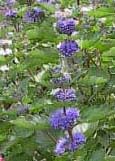 Bluebeard seems to be the most frequently used common name but two others are blue spirea or blue mist, both of which seem more descriptive. Whatever you call it, this shrubby perennial looks terrific in a perennial border when it blooms in late summer to early fall. The tiny flowers are borne in dense ball shaped clusters along long stems above aromatic gray-green leaves. North of zone 7 the stems will probably die back to the ground in the winter but the roots survive and send up new shoots in the spring. Many gardeners, including myself, cut back the plant to the ground even if it doesn’t die back. It always amazes me that the bush can regrow into a large bushy plant in the course of the summer but it faithfully does so. One caveat, although I love the look of this plant, I no longer grow it because it blooms for a short period of time and takes up a lot of garden space.
Bluebeard seems to be the most frequently used common name but two others are blue spirea or blue mist, both of which seem more descriptive. Whatever you call it, this shrubby perennial looks terrific in a perennial border when it blooms in late summer to early fall. The tiny flowers are borne in dense ball shaped clusters along long stems above aromatic gray-green leaves. North of zone 7 the stems will probably die back to the ground in the winter but the roots survive and send up new shoots in the spring. Many gardeners, including myself, cut back the plant to the ground even if it doesn’t die back. It always amazes me that the bush can regrow into a large bushy plant in the course of the summer but it faithfully does so. One caveat, although I love the look of this plant, I no longer grow it because it blooms for a short period of time and takes up a lot of garden space.
Type: Perennial.
Bloom: Tiny lavender blue flowers are borne in ball shaped clusters in late summer to early fall.
Size: 1 ½’-4’ H x 4’ W.
Light: Full sun.
Soil: Average, medium, well-drained; can not tolerate wet soil.
Hardiness: Zones 5-9.
Care: Cut back old wood in spring to ground to encourage new growth.
Pests and Diseases: None of significance; susceptible to crown rot in wet soil.
Propagation: Terminal cuttings in spring or early summer.
Companion plants: New England aster “Alma Potschke’, sedum ‘Autumn Joy’, coneflower such as ‘Magnus’, yellow lantana or mums.
Outstanding Selections:
-
‘Dark knight’ (darkest blue flowers)
‘Longwood Blue’ (silvery foliage, sky blue flowers, 2’ tall).
